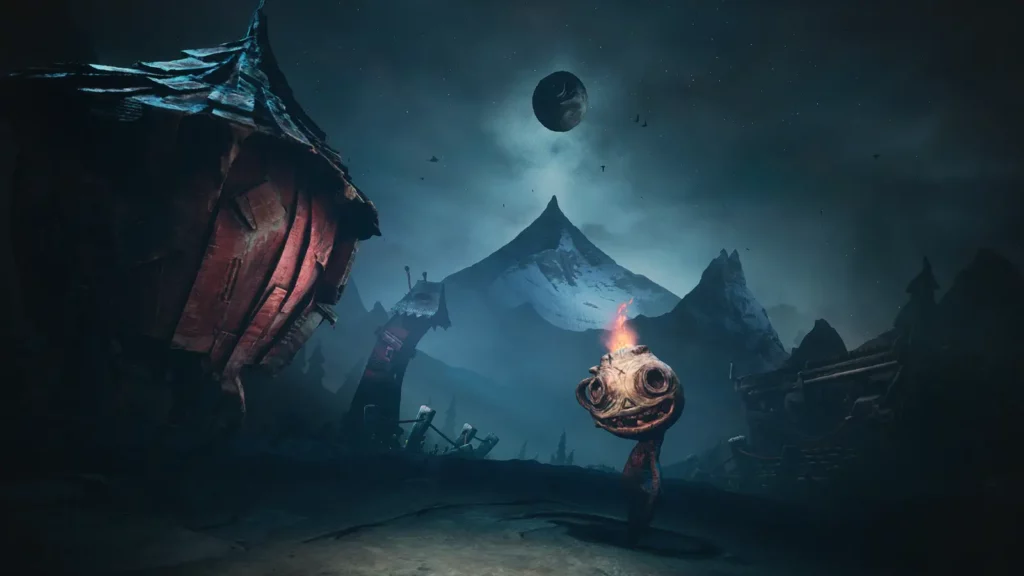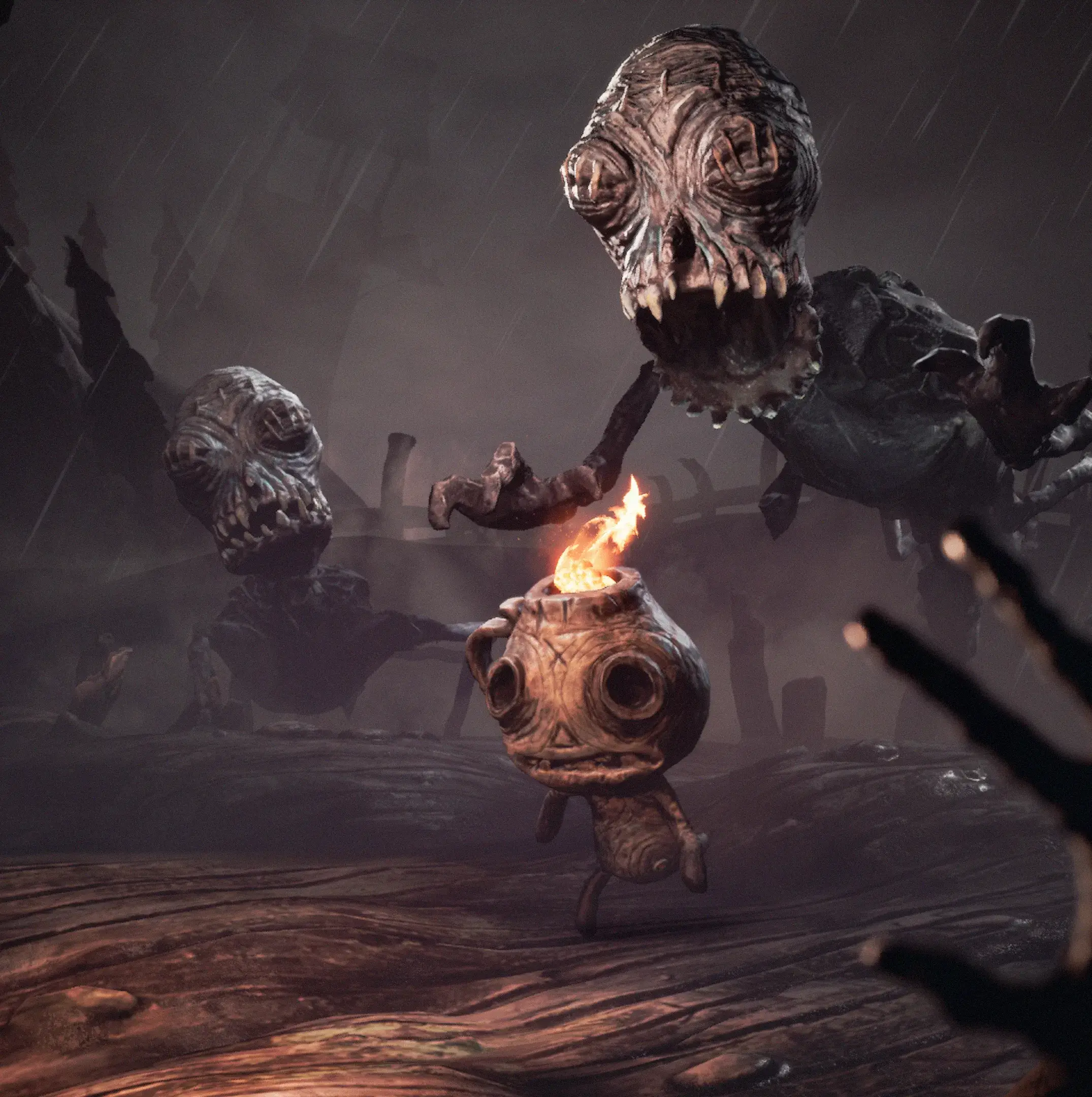The Midnight Walk begins with a whisper from myth — where darkness was all, and fire became the first light. It evokes ancient stories, from religious creation myths to the human triumph of harnessing fire. Flames don’t only guide; they also consume. That duality defines the game’s tone and story. Developer MoonHood Studios channels that primal symbolism into a beautifully unsettling stop-motion puzzle-horror experience. While not mechanically deep, its emotional and visual storytelling creates something unforgettable.
Rising from the Grave
The game’s eight-hour journey opens with a haunting image: a figure known as the Burnt One emerges from a grave. Another creature gifts them eyes and ears, allowing them to see and hear again. There’s no clear mission at first — just survival. The world is enveloped in endless night, stalked by malformed entities called Crawlers. These creatures stumble and lurch in unnatural ways, and players must use stealth and environmental cues to avoid them. Wardrobes offer refuge, while fire sources like matches and candles become vital tools for both solving puzzles and staying alive.
You’ll quickly realise that sight and sound aren’t always reliable. Closing your eyes might remove obstacles or reveal truths. Lighting a match can brighten a path — or trigger a reaction in something nearby. The Midnight Walk layers these mechanics gently, reshaping them throughout the game in ways that surprise and challenge without overwhelming.

Simple Mechanics, Clever Twists
Although the core gameplay is straightforward, it’s the way these mechanics are transformed that keeps things fresh. A single match can do more than illuminate a room — it can power a puzzle or be fired from a matchgun to reach distant switches. Wardrobes aren’t just hiding spots but portals between spaces. Looking directly at an object before closing your eyes might cause it to vanish when you reopen them. The game reshapes its rules constantly, stacking new concepts atop familiar ones to keep the experience evolving.
Occasionally, the game falters. Some stealth segments involving Crawlers and another entity, the Grinners, can feel clunky or trial-and-error based. Still, generous checkpoints keep these moments from derailing the journey too much.
A Companion Carved in Clay
Where the story truly finds its heart is with Potboy — a small, living piece of pottery who carries fire within him. At first, he’s terrified of the Burnt One, and understandably so. This world is cruel, and even fire attracts monsters who hunger for it. But as Potboy begins to trust, he becomes not just a helper but a symbol of fragile hope.
Your mission becomes to guide him to Moon Mountain, a place that might hold the key to restoring balance. Along the way, you encounter broken versions of Potboy — a reminder that this journey has played out before. Resurrection points scattered across the map confirm that failure is expected, but perhaps not final. If you look closely, there are hints that this world loops — that each step forward has been taken many times before.
Storytelling Without Spoon-Feeding
What makes The Midnight Walk stand out is its refusal to explain everything. Dialogue doesn’t cater to the player — characters speak as if they belong in this world, not as if they’re narrating it to outsiders. Understanding comes through observation. Scattered devices called Shellphones hold snippets of recorded memories and tales, but rarely identify their speakers. Players are left to piece together connections, uncovering truths through context rather than exposition.
Clay-Born Characters with Deep Stories
Every character is physically crafted from clay and scanned in to mimic stop-motion animation. The result is a world that feels handmade and alive. You’ll meet strange figures, like the twin-headed Soothsayers who worship fire and share cryptic guidance before fading. The Soulfisher, a mysterious presence who appears at every campfire, seems to wait for something unspoken. Housy, a walking house, is your mobile safe haven and memory keeper.
Some characters are introduced long before their purpose becomes clear. Others become companions or uneasy allies. Each interaction feels meaningful, whether tender or terrifying.
Vignettes of Sorrow and Memory
The Midnight Walk’s narrative unfolds through vivid and often devastating vignettes. A town of bodiless heads struggles with the sins of its past. A creature mourns its kind, now extinct. One girl, fascinated by stars, lights matches to feel close to them. Even stories that don’t resonate as deeply — like The Craftman’s Heart, which feels more like a tale told than lived — still add weight to the journey.
These stories are stitched with themes of loss, regret, and the desire for peace. You can’t undo what’s been done — the game makes that clear. But you can comfort. You can carry the fire, offer warmth, and witness. That, sometimes, is enough.
Visual Mastery with Purpose
The Midnight Walk is undeniably cinematic, though not in the traditional sense. It doesn’t rely on endless cutscenes or dramatic monologues. Instead, it controls pacing and perspective masterfully. Movement is often restricted to present key visual moments — a choice that enhances immersion, even when it briefly pulls away player agency.
The stop-motion animation, combined with careful lighting and framing, creates one of the most visually distinctive worlds in recent gaming. It supports VR on both Steam and PlayStation VR2, and though the standard version is impressive, virtual reality likely adds another layer of atmosphere.
Endings that Echo
There are two endings to discover, and while one feels more complete, the other resonates on a deeply emotional level. Players will likely have strong preferences — and that’s by design. The game doesn’t offer tidy conclusions, but instead invites reflection.
Though relatively short in length, the experience lingers. Each revisit to the world reshapes earlier moments with new meaning. As you learn more about its history and characters, your understanding evolves. That emotional growth is the game’s reward, far more than any collectible or achievement.
A Flame That Stays Lit
The Midnight Walk may not dazzle with complex mechanics or traditional puzzles, but its emotional depth and creative vision elevate it. Its use of light and dark, both literal and metaphorical, becomes a meditation on how we carry pain — and how we share warmth. The bond with Potboy is central to this, and watching his small, flame-lit body scurry forward becomes a symbol of trust and resilience.
By the time the final choice arrives, it no longer feels like just a story. It feels like something lived — and remembered.
